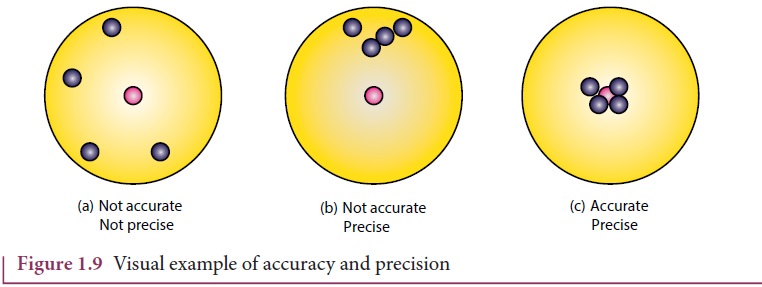Theory of Errors | Physics - Accuracy and Precision | 11th Physics : UNIT 1 : Nature of Physical World and Measurement
Chapter: 11th Physics : UNIT 1 : Nature of Physical World and Measurement
Accuracy and Precision
Accuracy
and Precision
Let
us say, you know your true height is exactly 5′9″. You first measure your height with
a yardstick and get the value 5′0″. Your measurement is hence not
accurate. Now you measure your height with a laser yardstick and get 5′9″ as the value. Now your measurement
is accurate. The true value is also called theoretical value. The level of
accuracy required for each application varies greatly. Highly accurate data can
be very difficult to produce and compile. For example, if you consistently
measure your height as 5′0″ with a yard stick, your
measurements are precise. The level of precision required for different
applications vary to a great extent. Engineering projects such as road and
utility construction require very precise information measured to the
millimeter or one-tenth of an inch.
If
a measurement is precise, that does not necessarily mean that it is accurate.
However, if the measurement is consistently accurate, it is also precise.
For
example, if the temperature outside a building is 40oC as measured
by a weather thermometer and if the real outside temperature is 40oC,
the thermometer is accurate. If the thermometer consistently registers this
exact temperature in a row, the thermometer is precise.
Consider
another example. Let the temperature of a refrigerator repeatedly measured by a
thermometer be given as 10.4oC, 10.2oC, 10.3oC,
10.1oC, 10.2oC, 10.1oC, 10.1oC,
10.1oC. However, if the real temperature inside the refrigerator is
9oC, we say that the thermometer is not accurate (it is almost one
degree off the true value), but since all the measured values are close to 10oC,
hence it is precise.
A visual example:
Target
shooting is an example which explains the difference between accuracy and
precision. In Figure 1.9 (a), the shots are focused so as to reach the bull’s
eye (midpoint), but the arrows have reached only around this point. Hence the
shots are not accurate and also not precise.

In Figure 1.9 (b), all the shots are close to each other but not at the central point. Hence the shots are said to be precise but not accurate. In Figure 1.9 (c), the shots are closer and also at the central point. Hence the shots are both precise and accurate.
A numerical example
The
true value of a certain length is near 5.678 cm. In one experiment, using a
measuring instrument of resolution 0.1 cm, the measured value is found to be
5.5 cm. In another experiment using a measuring instrument of greater
resolution, say 0.01 cm, the length is found to be 5.38 cm. We find that the
first measurement is more accurate as it is closer to the true value, but it
has lesser precision. On the contrary, the second measurement is less accurate,
but it is more precise.
Related Topics